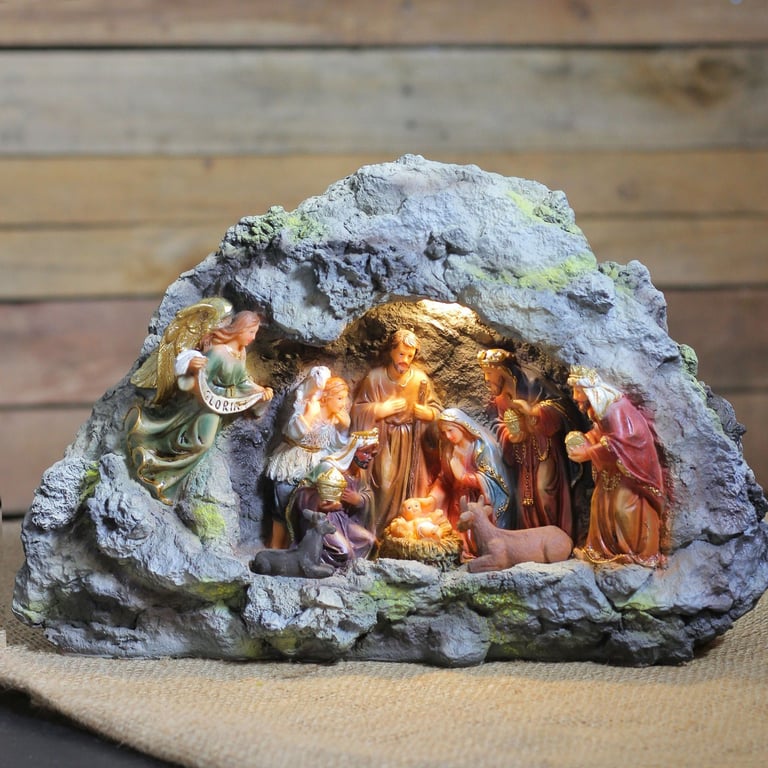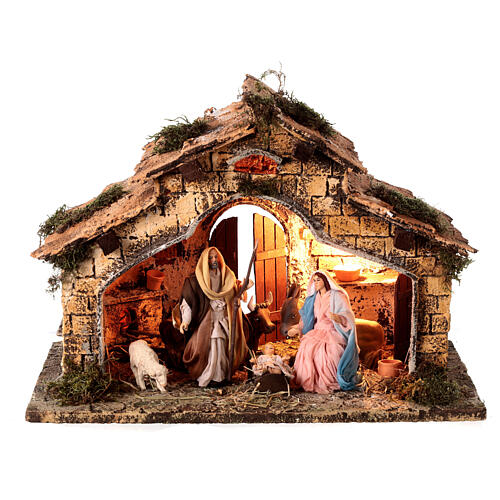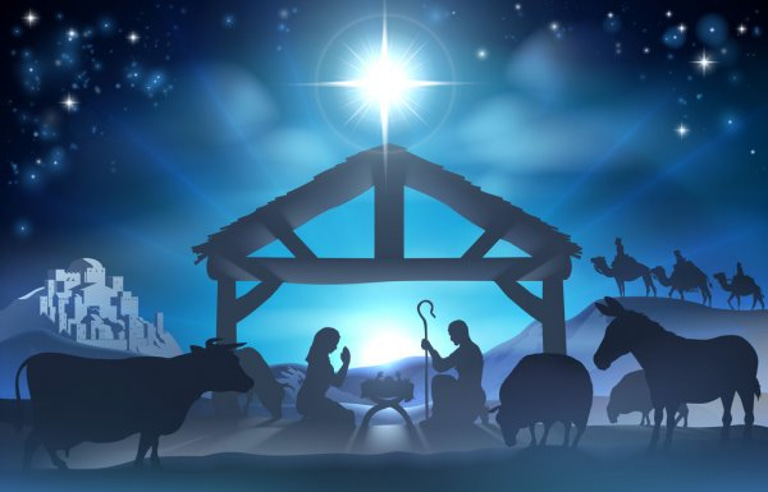Nativity Story: Unveiling the Mystery of The Stable vs. Cave
Ever wondered why we picture Jesus' birth in a stable? Explore the debate over Nativity locations and how views change over time.
Grace Callahan
11/18/20246 min read


The birth of Jesus Christ is not only one of the most pivotal events in Christianity, but it is also one of the most frequently depicted and celebrated moments in the world. Every year during Christmas, millions of people set up Nativity scenes to depict this sacred event. The most enduring and widely accepted image of that birth is one of Jesus lying in a humble stable, surrounded by animals like oxen, sheep, and donkeys, with Mary, Joseph, and sometimes shepherds or wise men gathered around. This image is so firmly entrenched in Christian tradition that it's hard to imagine a different scene.
However, for many centuries, Christian tradition held that Jesus was born in a cave, not a stable. The Cave of the Nativity, located beneath the Church of the Nativity in Bethlehem, is considered by many to be the actual birthplace of Jesus. So why, then, has the stable become the more dominant image in the way we understand and portray Jesus’ birth today? Why is it now the stable that is synonymous with the Nativity in much of Western culture?
In this post, we will explore how and why the stable replaced the cave in popular depictions of the birth of Jesus, considering the historical, theological, and cultural factors that influenced this shift. Additionally, we will discuss how commercialization and the growth of consumer culture played a significant role in making the stable the more marketable, recognizable, and beloved image for Christmas.
The Gospel Accounts: What Do the Scriptures Say?
Before delving into the history of the Cave of the Nativity and the stable, it is important to understand what the Gospels say about the birth of Jesus. The Gospel of Luke provides the most detailed account of Jesus' birth, mentioning that Mary and Joseph traveled to Bethlehem due to a Roman census. The famous line from Luke 2:7 says, “and she gave birth to her firstborn son, and wrapped him in swaddling cloths and laid him in a manger, because there was no place for them in the inn.”
From this account, we know that Jesus was born in Bethlehem and that there was no room in the kataluma (translated as “inn”), forcing Mary and Joseph to find alternative shelter. The specific details of the shelter are unclear—Luke simply says that Jesus was laid in a manger, which implies that the family was likely in a place where animals were kept.
This mention of a manger—a feeding trough for animals—has led many to assume that Jesus was born in a stable. However, the Gospel of Matthew also makes reference to the birth of Jesus, but with even less detail about the place of birth. The absence of specific descriptions in both Gospels leaves much to interpretation.
The Cave of the Nativity: Early Christian Tradition
The belief that Jesus was born in a cave comes from early Christian traditions, particularly those rooted in the Holy Land. In the early centuries of Christianity, Bethlehem was a small village, and it was not uncommon for people to use caves for shelter. These natural limestone caves served as homes, stables, or even places for worship. Some early Christian writers, including St. Justin Martyr (2nd century) and Origen (3rd century), describe the birth of Jesus as occurring in a cave.
By the 4th century, Emperor Constantine commissioned the construction of the Church of the Nativity in Bethlehem over the site traditionally believed to be the birthplace of Christ. This church was built over a cave, and the site became a major Christian pilgrimage destination. The cave was believed to be the very spot where Mary gave birth to Jesus, and it became a sacred site for Christians.
The cave remained a central part of Christian tradition for centuries, with pilgrims visiting Bethlehem to pray and reflect in this sacred space. In fact, early Christian art and iconography depicted the Nativity scene as occurring in a cave, reinforcing the belief that this humble setting was the birthplace of Jesus.
The Rise of the Stable: Cultural and Theological Shifts
While early Christians firmly believed that Jesus was born in a cave, the image of the stable gradually gained prominence, particularly in Western Christianity. This shift can be attributed to a variety of cultural, religious, and theological factors, which we will explore below.
1. The Influence of St. Francis of Assisi and the Live Nativity Scene
A major turning point in the shift to the stable came in 1223 when St. Francis of Assisi created the first live Nativity scene in Greccio, Italy. This live display, which depicted the birth of Jesus in a manger, was a powerful visual representation of the humility and poverty of Jesus' birth. While St. Francis did not explicitly reference a cave, his Nativity scene portrayed the birth of Jesus in a stable surrounded by real animals.
The popularity of live Nativity scenes spread quickly throughout Europe, especially in Catholic regions, and the stable became the dominant image. People could relate more easily to a stable, which was a familiar structure in rural Europe. A stable symbolized simplicity, humility, and poverty, which were central themes in the Nativity story.
2. The Evolution of Medieval Art and Literature
As Christian art evolved throughout the medieval period, the image of the stable began to overshadow that of the cave. Artists began to depict the Nativity with a wooden stable, often filled with animals like donkeys, sheep, and oxen. These depictions became widely accepted as the norm in both religious paintings and Nativity performances.
By this time, the stable had become more than just a setting for Jesus’ birth—it had become a symbol of Christ’s humility. Medieval theologians and artists emphasized that Jesus was born in a stable to highlight the stark contrast between the glory of God’s Son and the lowly conditions into which He was born. The stable portrayed the King of Kings being born into the most humble of circumstances, fulfilling the prophecy that the Messiah would come in humility.
3. Linguistic Shifts and Translation of the Bible
Another factor contributing to the shift from the cave to the stable lies in the linguistic evolution of the Bible’s translation. The Greek word used in Luke 2:7 is “kataluma”, which refers to a guest room or a place of lodging, not necessarily an inn as we understand it today. In some translations, the word is interpreted as implying an animal shelter, such as a manger or stable, a common arrangement in rural areas like Bethlehem.
Over time, this misunderstanding of the term “kataluma” influenced popular thinking. As Christian traditions evolved, the stable became the most popular setting for Jesus' birth, in part because of the familiarity of that image to Western Christians.
Commercialization and the Shift to the Stable
In the 19th and 20th centuries, as Christmas became more commercialized, the stable image of the Nativity grew even more prominent. As Christmas traditions became increasingly market-driven, the stable became the more marketable and accessible image for Nativity scenes, decorations, and holiday paraphernalia.
1. Consumer Culture and the Market for Nativity Sets
The stable became the standard image for Nativity scenes because it was more visually appealing and relatable to the masses. Commercial manufacturers began to produce Nativity sets featuring wooden stables, adoring shepherds, and animals that were easy to market to middle-class families around the world. The shift to the stable allowed retailers to create beautiful, sentimental displays that emphasized the humble and heartwarming aspects of the Nativity story.
The rise of Christmas cards, holiday decorations, and gifts further reinforced the stable imagery, as it fit well with the commercialization of the Christmas season. Advertisers and businesses leveraged the stable as a symbol of warmth, family togetherness, and simplicity—themes that were easily tied to consumer products.
2. Accessibility and Universal Appeal
The stable also had the advantage of being more universally recognizable than a cave, especially for audiences outside of the Holy Land. A stable
was a simple, everyday structure, more familiar to people in rural and suburban settings. This made the stable more accessible and easier for people to relate to, both in terms of visual imagery and symbolic meaning.
Conclusion: The Message of Humility Remains the Same
Though the shift from cave to stable in the Nativity story can be explained by historical, cultural, and linguistic factors, the message of humility and simplicity remains unchanged. Whether depicted in a cave or a stable, the story of Jesus’ birth is one of God coming into the world in the most humble and unassuming way possible. The stable may now be the dominant image, but the core message of God’s love, humility, and grace remains the same.
As we continue to celebrate the Nativity during Christmas, whether in a cave or a stable, we are reminded of the incredible humility of the Savior’s birth, which transcends time, culture, and tradition.



Please see my related posts
The Role of Animals in Nativity: Faith and Tradition
Perfecting Your Nativity Scene: Common Figure Setups
Artistic Roots of Elephant Imagery in the Nativity Scene
The Star of Bethlehem: A Beacon of Hope in the Nativity
How the First Nativity Scene Came to Life: A Rich History
Faith and Humility: Joseph's Key Contribution to the Nativity
The 3 Wise Men’s Journey: Their Mode of Travel Revealed
